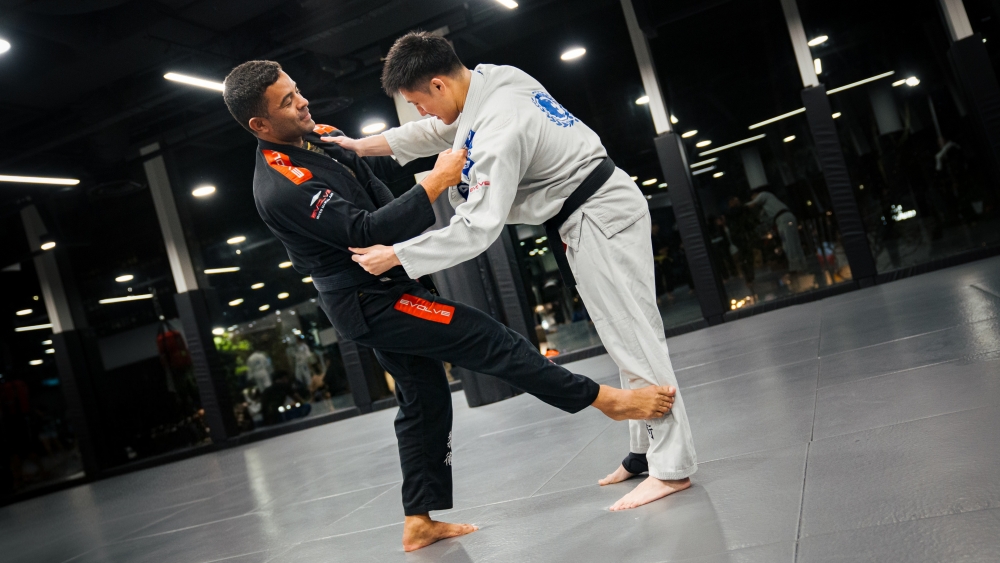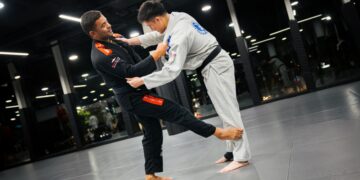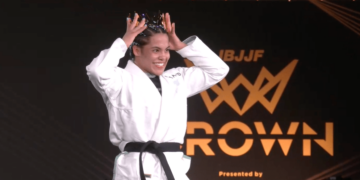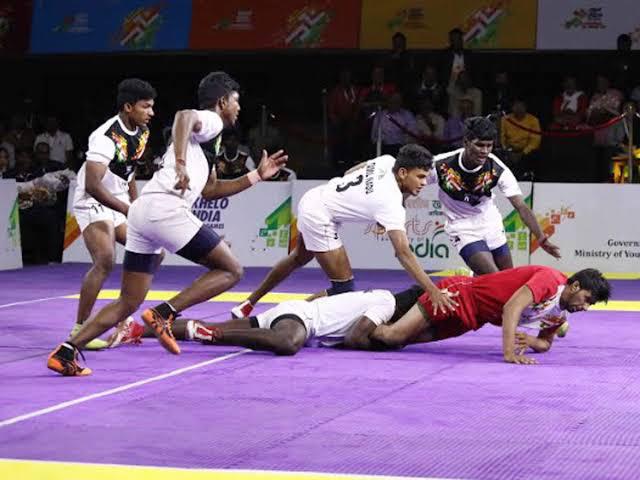
Summary
In Brazilian Jiu-Jitsu, a trip is a standing technique used to unbalance (Kuzushi) your opponent and take them down by targeting their legs. Unlike powerful judo throws that lift or launch an opponent, trips rely on subtle weight shifts and well-timed footwork.
Trips are particularly useful in BJJ because they require little space and are easy to connect during exchanges, grip fighting, and guard passes. They also flow naturally from tie-ups and collar grips, making them efficient for both Gi and No-Gi settings.
Trips rely more on balance, leverage, and timing than brute strength, making them valuable for practitioners of all levels. This guide explains what BJJ trips are, how they differ from throws, and key examples you can add to your game to improve your takedown success.
The Role Of Balance And Timing
Successful trips depend on disrupting your opponent’s center of gravity. You don’t need to force them down, you guide them at where their balance is weakest.
Timing comes from feeling when your opponent’s weight shifts to one leg. That’s your cue to sweep or hook the other leg while maintaining control of their upper body. The more you practice sensing this weight transfer, the easier it becomes to trip opponents smoothly.
Common Types of BJJ Trips
1) Inside Trip (Uchi Mata Entry Variation)
The inside trip uses your leg to hook the inside of your opponent’s thigh while pulling them forward with grips. This trip works well when your opponent’s weight is slightly over their lead leg.
How It Works:
- Establish a collar and sleeve grip (Gi) or underhook and head control (No-Gi).
- Step close and lift your leg between theirs.
- Pull their upper body toward you as you lift and turn your leg inward.
- Follow them down to control position or side control.
This move combines leverage and hip engagement to unbalance opponents effectively.
2) Outside Trip (Osoto Gari Style)
The outside trip is one of the most fundamental takedowns in grappling. You use your leg to block your opponent’s outer leg while driving their upper body backward.
How It Works:
- Maintain a tight grip or overhook.
- Step to the side and sweep your leg behind their stance leg.
- Push with your chest while pulling their arm across.
- You should land in a dominant position such as side control.
The outside trip works well for both aggressive entries and defensive counters when your opponent moves forward.
3) Foot Sweep (De Ashi Barai)
Foot sweeps are quick and precise. Instead of pushing or pulling forcefully, you redirect your opponent’s momentum by lightly sweeping the foot as it moves.
This trip relies heavily on timing. When your opponent steps forward, sweep the heel of that foot just before it touches the mat. It’s a technique of finesse rather than strength and can be chained into passes or submissions right after the takedown.
4) Inside Hook Trip (Ko Uchi Gari)
The inside hook is one of the most common trips used in both Judo and BJJ. You control your opponent’s upper body and hook the inside of their ankle to pull them forward or sideways.
This is often used when opponents resist being thrown backward. By changing direction, you can catch them by surprise and finish in a stable top position.
5) Body Lock Trip
Body lock trips are commonly used in No-Gi BJJ and MMA. Once you secure a body lock, you can use small steps and leg hooks to unbalance your opponent and guide them to the mat.
Focus on keeping your chest close to theirs, maintaining pressure, and staying centered. You can trip to either side depending on how they react, making this one of the most versatile takedown options in BJJ.
Training Drills To Improve Trips
- Balance And Footwork Drills: Practice shifting your weight side to side to develop better stability and sensitivity to movement.
- Solo Drills: Rehearse trip motions without a partner to refine accuracy and foot placement.
- Grip Flow Practice: Alternate between collar, sleeve, and body grips to learn how to transition smoothly into trip setups.
- Light Rolling With Partners: Work with light resistance to feel how small shifts in posture affect timing.
The goal is to blend movement and awareness until the trip becomes a natural reaction rather than a forced motion.
Common Mistakes When Attempting Trips
- Pulling without moving your feet
- Relying too much on strength
- Forgetting to maintain upper-body control
- Standing too upright during the motion
- Not following through to control the landing
Trips work best when you stay low, connected, and calm. Focus on precision, not speed.
FAQs On BJJ Trips
Q: Are Trips Legal In All Levels Of BJJ Competition?
A: Yes. Most trips are legal under IBJJF rules, as long as they don’t involve slamming or dangerous reaping motions.
Q: What’s The Difference Between A Trip And A Throw?
A: Trips rely on small weight shifts and leg hooks, while throws usually lift or project the opponent using momentum and hip engagement.
Q: Can Smaller Practitioners Use Trips Effectively?
A: Absolutely. Trips are based on timing and leverage, making them perfect for smaller or lighter athletes.
Q: Should I Learn Trips In Both Gi And No-Gi?
A: Yes. The grips differ, but the principles of balance, timing, and control are the same.
Q: What’s The Best Way To Practice Trips Safely?
A: Start slowly with a cooperative partner. Focus on balance, control, and smooth transitions rather than impact.
Final Thoughts
Trips are one of the most efficient ways to bring your opponent to the ground in Brazilian Jiu-Jitsu. They teach you how to control distance, redirect force, and stay composed during takedown exchanges.
By refining your timing and connection, you’ll find that even subtle movements can shift the balance of a match in your favor. Whether you train for sport or self-improvement, mastering trips builds confidence and control both on and off the mats.
You may also like:
BJJ 101: Breakfalls
Summary A breakfall, known as ‘ukemi’ in Japanese martial arts, is one of the first techniques students learn in Brazilian Jiu-Jitsu. Instead of resisting a fall, you guide your body toward the mat and use…
Summary The Seoi Nage, also known as the shoulder throw, is one of Judo’s most iconic and widely practiced techniques. The name literally translates to “shoulder throw” (Seoi meaning “to carry on the back,” and…
Summary The penetration step is a fundamental wrestling movement used to close the distance and drive power into a takedown. It’s not just a forward step but a full-body motion that helps you shoot deep…
Summary Osoto Gari, meaning “major outer reap” in Japanese, is one of the most effective and widely used throws in grappling. Originally from Judo, it has become a staple in Brazilian Jiu-Jitsu because of its…
Summary Every Brazilian Jiu-Jitsu practitioner eventually finds themselves caught in an armbar. It’s one of the most common submissions in the art. While the best defense is prevention, knowing how to escape when it happens…
Summary In Brazilian Jiu-Jitsu, control always comes before submission. Before you can attack effectively, you must secure a stable position, and the seat belt is one of the best ways to achieve that. The seat…
Summary In Muay Thai, knees are used from close to mid range and are one of Muay Thai’s most devastating weapons. They can stop an opponent’s forward pressure, drain their stamina, or end a fight…
Summary The L step is a movement pattern where you step diagonally backward and to the side, forming a “L” shape movement. It allows you to move off the centerline and create angles while maintaining…
Summary Metabolism refers to all the chemical processes that keep your body functioning. It turns the food you eat into energy for movement, training, repair, and daily living. A faster metabolism burns more energy, while…
Summary There isn’t a single “best” martial art, only the one that suits you best. Whether you want to get fitter, learn self-defense, or explore something new, each discipline offers its own set of benefits….
Summary Singapore’s fitness landscape is evolving faster than ever. From high-intensity race formats to group circuits and skill-based training, more people are asking not just how to get fit but what kind of fit they…
Summary Diet trends often come and go, but one debate that continues is meal frequency. Some people swear by eating every few hours to “keep metabolism high,” while others prefer two or three bigger meals…


![[WATCH] Virat Kohli opens up on fondness for Chinnaswamy Stadium](https://lbsports88.com/wp-content/uploads/2025/11/watch-virat-kohli-opens-up-on-fondness-for-chinnaswamy-stadium-360x180.jpg)



![[WATCH] IND vs SA 2025: Rishabh Pant vents frustration at Kuldeep Yadav for slow over-rate warning](https://lbsports88.com/wp-content/uploads/2025/11/watch-ind-vs-sa-2025-rishabh-pant-vents-frustration-at-kuldeep-yadav-for-slow-over-rate-warning-360x180.jpg)

























![[WATCH] Virat Kohli opens up on fondness for Chinnaswamy Stadium](https://lbsports88.com/wp-content/uploads/2025/11/watch-virat-kohli-opens-up-on-fondness-for-chinnaswamy-stadium-120x86.jpg)



![[WATCH] Virat Kohli opens up on fondness for Chinnaswamy Stadium](https://lbsports88.com/wp-content/uploads/2025/11/watch-virat-kohli-opens-up-on-fondness-for-chinnaswamy-stadium-350x250.jpg)